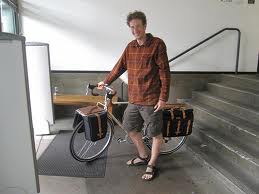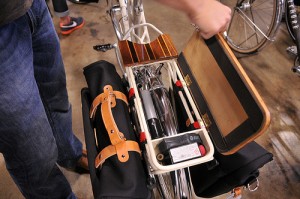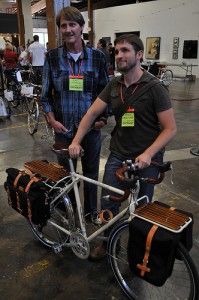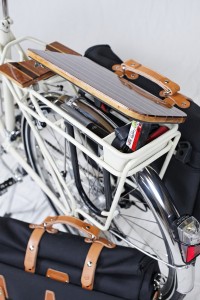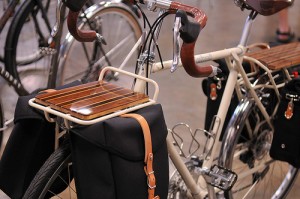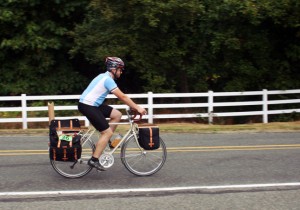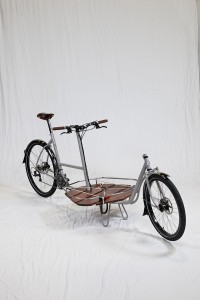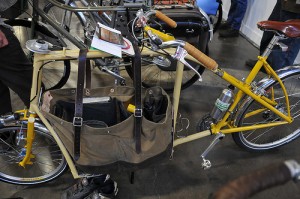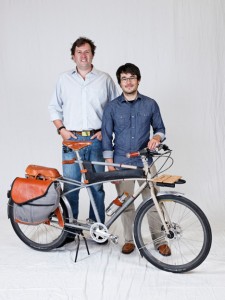Oregon manifest (Sep 23, 24) was fun. Friday was especially exciting. The space was a little too small and without air conditioning. Perfect for an indoor bike event on a hot September night. Folks poured in and kept on coming- the place was packed tight with people, so that a close-up of any particular bike meant a conscious and concentrated effort. The bikes were beautiful! Every builder seemed to take a different direction. I was really impressed by all of the intelligent and truly practical designs in this one place. Inspirational!
Here are some photos of the Littleford entry and some of my favorite other entries…
The Photos are all thanks to other folks. I only took my film camera… and of course I still haven’t developed the film. (Daily shooter, semi-monthly see-er.)
|
|
Speaking of Oregon Manifest…what’s this about electric assist?
There seems to be increasing interest and overall embrace of electrically assisted “e-bikes” lately. There were three such bikes entered in Oregon Manifest, and two of them won awards. (First place and people’s choice.) Regarding the first place winning entry, a cruiser-style moped with a handlebar mounted trunk and integrated boom box, Tinker Hatfield of Nike stated that “We need to adjust our view of the cycling future. This is the future of cycling for people who aren’t super-fit.”
Maybe he’s right. Maybe lithium cell powered mopeds are the next incarnation of two wheeled transport in America. But I think it’s backwards thinking to say that one needs to be super fit to get to work by their own means.
A Chinese grandmother pedaling a 45 pound wrought-iron-wreck 5 1/2 miles through the smog to the garment factory is not super fit. Nor is a Rwandan 12 year old boy moving his weight in chickens across the landscape for 4 straight hours to the market.
These are everyday people at a historically normal level of human fitness.
An American metropolitan commuter that needs a (statistically 57% coal powered) electric motor and sound system to lure him out of his gasoline powered car to get to work probably needs exercise far more than he needs yet another motor in his life. His choice to transport himself in whole or in part by electric motor has nothing to do with not being “super fit”. (If anything, his poor fitness level is the result of a lifelong addiction to motors…)
Further, as a friend pointed out recently, the lifespan of a lithium ion battery is about 5 years. That means that every 5 years another large lithium battery has to go somewhere as waste. And, as people are finally coming to realize in an increasingly toxic and soiled world, there’s no throwing these batteries away because there is no”away”.
In contrast, an enterprising mother that can move a 60 pound cargo bike with 2 small children and a week’s groceries all over town or country on a day’s errands is super fit. And even for an athlete, this kind intense workout in the course of the day’s chores is not sustainable as daily routine. Here is a case for an electric motor.
I had a conversation with a homeless man a few weeks ago. He had asked me where he could get one of those motors for his bike. Never mind that, since I was in plain clothes exiting a grocery store, there was no evidence that I knew any more about hub motors or bicycles in general than anybody else. I quickly said “Bahh! Why do you need an electric motor?” He told me that he had a hard time on the hills, because his heart wasn’t too good. Sometimes he had to stop and take a break.
My response was “Hmm. I guess you do need a motor then,” But as we continued to talk, it occurred to me, Why? Why does he need a motor? So what if he takes a break? The light, mindful exertion that comes with riding a bike is probably the best thing for his heart… and so what if he takes a break. So what if he takes three. Is he running late for somewhere? Probably not. I brought this point up to him- that he didn’t need a motor because he didn’t need to hurry, and that so long as he paid attention to his body, the exercise was only helping him.
He answered “Well, yeah. Nobody needs to hurry. And I do like to ride around. What’s the rush, right? But I’d still get a motor for sometimes.”
Well said. Electrical assist… for sometimes.

